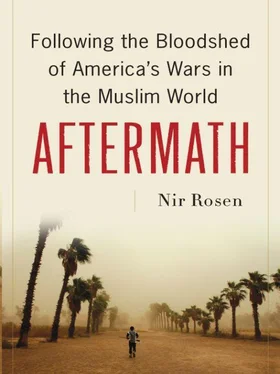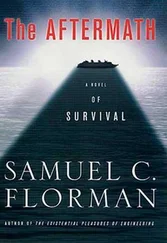ALMOST ON ARRIVAL in February 2007 Petraeus headed straight to Ramadi, capital of the Anbar province, to see Col. Sean McFarland of the First Brigade, First Armored Division. McFarland’s brigade had been in Ramadi since June 2006. Before that they had been in Tal Afar, where soldiers were practicing an approach called “clear, hold, and build” and living in combat outposts (COPs) with the townspeople. While these outposts initially suffered heavy attacks, in battle the Americans usually dominated, and attacks fell after the first summer.
(Capt. Robert Chamberlin believed the real reason Tal Afar was pacified was the cleansing of its Sunnis and the tacit American support this received. After serving in Tal Afar he wrote an article in Military Review in 2008. “Shiites now dominate a community that was formerly 70 percent Sunni,” he explained. “Shiites made up 98 percent of the applicant pool in a July 2007 recruiting drive for the local police. The Sunnis moved to nearby villages and sought shelter with families and tribes, but they still think of Tal Afar as ‘their’ city.”)
Living in COPs allowed the Americans to have greater access to Ramadi’s infrastructure and to reach out to local leaders. In the early days of the U.S. invasion, these leaders had generally supported the resistance. They eventually turned against Al Qaeda, but their attempts to expel the group in 2005 failed. The tribes were crushed, killed, and forced to flee. This time they had American support; that made a difference.
McFarland initially found a city dominated by Al Qaeda-linked groups with almost no Iraqi Security Forces. He set up tribal militias called provisional auxiliary police and stationed them so they could protect their own area. The Americans protected the homes of collaborating tribal leaders. Instead of warning that they would soon be leaving, the Americans promised to remain as long as it took. McFarland believed it was his attempt to recruit thousands of locals to the Iraqi police that led to what would be called the Sons of Iraq program—known in Arabic as Al Sahwa (the Awakening)—in which previously antagonistic Sunni militias began to cooperate with the Americans. Brutal Al Qaeda retaliatory attacks on police and the tribal leaders who backed them increased local hatred of the group.
The Americans found a young “sheikh” called Sattar Abu Risha. He was not exactly a tribal leader, and he was not exactly fighting for freedom, but he was willing to fight Al Qaeda in return for American support. Unlike past rebellions against Al Qaeda, this time the Americans propped up their new ally. They had two Marine battalions in downtown Ramadi, and they parked a tank in Abu Risha’s front yard and visited him twice a day. In September 2007 Abu Risha held a conference establishing the Anbar Awakening. More and more tribes in the area joined. When Awakening tribes were attacked, the Americans provided air and armor support and rescued them.
“The enemy overplayed its hand and the people were tired of Al-Qaeda,” McFarland wrote in a 2008 article in Military Review . “A series of assassinations had elevated younger, more aggressive tribal leaders to positions of influence. A growing concern that the U.S. would leave Iraq and leave the Sunnis defenseless against Al-Qaeda and Iranian-supported militias made these younger leaders open to our overtures. Our willingness to adapt our plans based on the advice of the sheiks, our staunch and timely support for them in times of danger and need, and our ability to deliver on our promises convinced them that they could do business with us. Our forward presence kept them reassured.” Petraeus supported the introduction of the Awakening phenomenon elsewhere. Paying people who used to shoot at Americans was a radical step, but he did not consult his chain of command. “Petraeus did what he wanted to do and sought approval after, and he had enough clout to do it,” an American intelligence official told me.
IN DECEMBER 2006, when Washington began to push new troops to Baghdad, General Casey, the head of Multi-National Forces Iraq (MNF-I)—the U.S. military formation that provided overall command and control for operations in Iraq—summoned the Iraqis and laid out the new “surge” plan with Prime Minister Maliki, Defense Minister Abdul Qader Muhammad Jassim, Interior Minister Jawad al-Bolani, and the First Cavalry team. The Americans called it the Baghdad Security Plan, while the Iraqis called it Fard al-Qanun (Imposing the Law). Maliki approved the concept and committed to bringing in more Iraqi troops and letting the Americans “target all criminals,” which included Shiite militias and Sadrists. It was a momentous step for Maliki, whose collaboration with Shiite militias was viewed by the Americans as an obstacle to their goals.
Proponents of counterinsurgency obsessively study the history of so-called “small wars,” such as the British war in Malaya, the American war in the Philippines, the French war in Algeria, and the wars in Vietnam. Their doctrine emphasizes using the least amount of violence against the enemy, becoming familiar with the occupied country’s culture, and working to remove support for the insurgents. While this requires killing those who cannot be “reconciled,” it also requires creating local proxy forces and finding political solutions that the civilian population can see as a better alternative to backing insurgents. Proponents of COIN strategy realized that American tactics in Iraq had until then relied on brute force and killing.
COIN theorists never answered (or even asked) questions such as, Should the Americans have invaded Iraq or Afghanistan in the first place, or should they be occupying other countries? Instead they focused on practical matters such as implementation. To them the American reliance on brute force was counterproductive, and the numerous “decapitation operations” in which insurgent leaders were assassinated were not useful. They exhorted less violence, fewer “kinetic operations,” which only alienated people. They urged military and civilian agencies to collaborate and to understand the concerns of the people and address them, providing security and responding to their grievances.
American casualties peaked when their forces were involved in clearing insurgents from the belts. Once they transitioned to the hold-and-build phase, U.S. casualties declined drastically. But the extent to which the Americans protected the Iraqi population during the surge has been romanticized. American airstrikes killed more than 250 civilians in Iraq in 2006 but more than 940 in 2007 and another 400 in 2008. Thus, Americans killed more civilians in 2008 than in 2006, at the peak of the civil war—this despite the fact that the much-lauded scripture of the military’s COIN manual states, “The employment of airpower in the strike role should be done with exceptional care. . . . Even when justified under the law of war, bombing a target that results in civilian casualties will bring media coverage that works to the benefit of the insurgents.” In addition, artillery was used often during the surge for the purpose of “terrain denial,” even when that terrain was a populated area. This must not have felt very population-centric to the population.
On January 11, 2007, the “Crisis Committee” had its first meeting in Baghdad, at which the Baghdad Operation Center was set up and Lieut. Gen. Abud Qanbar was designated as its commander. The BOC was formed to give the Americans a counterpart in the battle of Baghdad, to be Maliki’s face in Fard al-Qanun.
Initially, the Americans didn’t want the BOC to be under Maliki’s direct control; they wanted it to be under the Defense Ministry’s command. Nor did they want Qanbar to lead it at first. The Iraqi general seemed too Soviet in his style and was too close to Maliki, but Qanbar proved flexible and able to learn. Brig. Gen. John Campbell, deputy commander of the First Cavalry Regiment, mentored Qanbar and also played a vital role in the success of the Awakening. He took Qanbar to meet some of the Awakening men, and Qanbar realized he knew them from the Saddam-era military. “Brigadier General Campbell had exceptional rapport with our Iraqi partners,” observed Maj. Andy Morgado, who served as a division maneuver planner and later as a combined arms battalion operations officer.
Читать дальше











